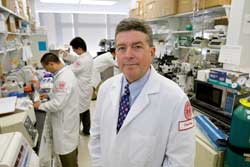Merit_award
|
The fable “The Tortoise and the Hare” comes to mind when you talk with School of Medicine researcher Steven Houser, who’s been studying ways to rescue ailing hearts for more than three decades at Temple’s School of Medicine. He admits others in his field work faster and have more publications, but they don’t have the reputation Houser’s rightfully earned here and abroad as being slow, but careful. Add consistent to that list, as Houser has been applying for and received grant funding from the National Institutes of Health for the past 25 years for a specific grant aimed at finding novel ways to repair hearts. That consistency paid off this fall when Houser became the School's first recipient of the National Heart, Lung and Blood Institute Method to Extend Research in Time (MERIT) award, a prestigious 10-year research support award that's only given to - at most - seven investigators each year. |
 Joseph V. Labolito / Temple University
Steven Houser, director of the Cardiovascular Research Center, has received the National Heart, Living and Blood Institute Method to Extend Research in Time (MERIT) award.
|
This can be the rock that gives me the ability to takes risks in other grants because I know I’m going to have this grant for a while,” said Houser, Ph.D., chair of the department of physiology and director of the Cardiovascular Research Center. “It will stabilize my staff and I can get fellows funded in other ways.” At $5 million, the award guarantees Houser funding for years. Given his productive past, he expects he’ll pass an expedited review process at year five and get five more years of funding. While it may sound routine, receiving the MERIT award is anything but. Consider that fewer than 5 percent of all NIH-funded researchers are recipients. In order to qualify for the MERIT award, nominees must have received at least 10 continuous and consecutive years of NIH funding. And with each grant submission, investigators must get a favorable score on their original application and continue getting better scores again and again — in essence, competing with themselves. By receiving the MERIT award, Houser is relieved of the need to prepare frequent and tedious renewal applications, a luxury fellow School of Medicine researcher Nae Dun has enjoyed since receiving the Jacob Javits Neuroscience Investigator award — a similar NIH award that lasts seven years. “Usually a grant is only good for three or four years and then you have to start thinking about getting it renewed,” said Dun, Ph.D., chair of the department of pharmacology. “With my award, I had the luxury of knowing I would have continuous funds and freely explore without the fear of having my funding pulled.” Dun received his award during his 19th year of applying for grants related to neurological research. And as Dun’s grant ends in just a few months, Houser looks forward to the beginning of his grant period — and the beginning of research in a new laboratory in the new medical school building. The new space may be just a block away from the old, windowless lab where Houser has worked for a quarter of a century in unraveling the causes and treatment of heart disease, but it offers a view and opportunity that stand a world apart. “This building has the ability to take us to higher ground — and I can tell you, it’s already had an impact,” said Houser. “It raises our education profile and I think with our facilities and faculty, our research profile can go way up, too.” And that’s just what the MERIT award will do, according to the School’s dean, John M. Daly. “The award will likely give rise to new NIH research programs that will result in patents and corporate licensing agreements that will benefit us along with patients,” said Daly. “And that will elevate our school right alongside the finest biomedical research institutions in the country.” That position is right where Temple belongs, adds Daly: with a steady hand at the helm of heart disease research. And while Houser admits his team and his field have made progress over the past 25 years in saving hearts that aren’t working properly, they haven’t yet “hit that home run.” Still, that doesn’t stop him from swinging for the fences. |
|